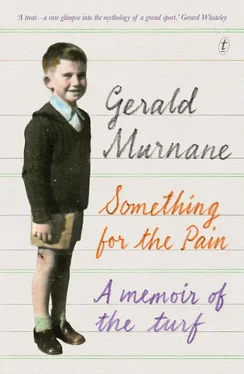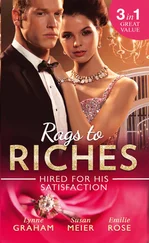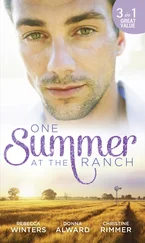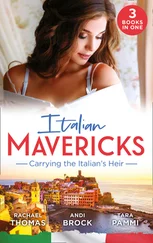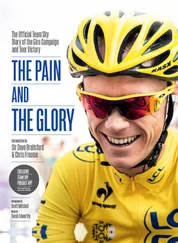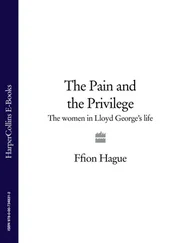I had not then learned to observe the behaviour of horses and jockeys during a race, but my father told me after Sir Flash had won by two or three lengths that the jockey had spent most of his time in the straight trying to stop the horse from winning by three or four times its eventual margin. It may have been my father or Uncle Louis or someone else of their acquaintance who first muttered that Sir Flash may well have been a ring-in. Correct weight was duly declared, but the considerable number of people who went to the birdcage to see the horse rubbed down were surprised to find that Sir Flash had been led straight from the course. This in itself was suspicious, and the more so when people recalled that the horse had not arrived at the course until shortly before its race.
Stewards’ practices sixty years ago were lax indeed by comparison with today. Every horse had its distinctive brand, and its registration papers described its natural colour and markings. Plus, a steward was supposed to go around the birdcage long before each race, asking to inspect the registration papers for each runner and comparing what was on the papers with what was on the horse. And yet, who knows what short-cuts a steward may have taken at a meeting at Warrnambool on a hot day in the early 1950s? Who knows how carelessly a steward may have looked at a forged set of papers or an altered brand? Perhaps a lazy or hasty steward may have waved his hand indulgently after some agitated trainer or strapper had told him that the papers had been left by mistake in a car at the far end of the car park, or that the horse had still not arrived on course because its float had broken down on the other side of Warrnambool? If the city performer Regal Vista was successfully rung in for the poorly performed Royal School at Casterton in 1972, why could not Sir Flash, twenty years before, have been not the horse of that name but the winner of open handicaps at Murray Bridge or Gawler or even Morphettville?
Ring-in or not, Sir Flash took much money from the bookmakers that day, and the horse’s connections got their share of it. They would have taken their winnings in a north-westerly direction. After the race, one of my father’s acquaintances, annoyed that he’d had only a small bet on the horse, jabbed his finger at the printed summary of Sir Flash’s form in the race book. What sort of jumping races had the horse contested, the man wanted to know. By what right had this dashing flat-racer got himself entered in a race for jumpers? He read out the information that Sir Flash had started most recently in a jumping race at Apsley, in far-western Victoria, and before that in a similar race at Penola in South Australia. My father’s friend was not alleging that Sir Flash was not the horse that had finished unplaced in two weak jumping races. What he seemed to be saying was that jumps at Apsley and Penola were lower or easier than at other courses and that the connections of Sir Flash had somehow cheated their way into the race at Warrnambool. He seemed to be blaming a bunch of Borderers for doing what any horse’s connections would have done if they had had half the chance.
After my wife had died, a few years ago, I moved to a small town in what some would call the north-west of Victoria but I like to call the far west. The town lies outside the pointy triangle made by joining up the places where Concito had three consecutive starts many years ago — but not far outside. This is definitely Border Country. And yet, the Borderers are not like the folk I imagined in the years when some of their number brought horses to the summer meeting at Warrnambool. Since I moved here, I’ve been to race meetings at Mount Gambier, Penola, Naracoorte, and Bordertown in South Australia, and at Edenhope, Casterton, Horsham, Nhill, and Murtoa in Victoria. I’ve seen much good racing. I’ve heard, while leaning on the fence of many a mounting yard, absorbing exchanges between owners and trainers and jockeys. What I’ve seen and heard, however, seems to suggest that most connections can only hope for success. No trainers or owners in this far-reaching district seem even to plan, let alone bring to fruition, the sort of coup that my Borderers of long ago brought, or were supposed often to bring. Even the betting is on a much-reduced scale. I’ve watched owners or trainers walk from the mounting yard after their horse has gone onto the track and bet twenty or, perhaps, fifty dollars on it with one of the few bookmakers fielding. For heaven’s sake! Fifty dollars today wouldn’t equal a pound in 1960, when I began as a primary teacher. I used to take five or ten pounds to a race meeting. My bet would be ten shillings or a pound. That’s either twenty-five or fifty dollars at least in today’s money. But I was so ashamed of my small bet that I would never have approached a leading bookmaker with my miserable stake. And now I see owners or trainers betting what I was ashamed to bet as a young teacher who lived from pay cheque to pay cheque.
I’ve learned much about racing from the meetings I’ve attended here in Border Country. I’ve seen tough-looking men and women brushing away tears after their horses have won maiden races with a first prize of only five thousand dollars. I’ve seen part-time trainers or owner-trainers lovingly grooming and then leading back towards the car park some horse that has started thirty times for one win and a few placings. I’ve seen much more that I feel privileged to have seen, but I’ve seen hardly anything of what I would have expected to see if someone could have told me in the 1950s that I would one day live among the Borderers and would observe them from close at hand.
So, this section of my book is just another variation on the old theme of the grass’s being greener on the far side of the hill — or, is it? In 2012, the publisher Michael Heyward, whom I’ve known for thirty years, expressed an interest in visiting me here, near the border. He wanted not just to see how I was surviving here but to observe the district and some of the people who live here. Michael arrived here in the hot days of late January with his wife, Penny Hueston, and William and Anna, two of their adult children. I was pleased to show them Lake Ratzcastle, to take them to the top of Mount Arapiles, and to serve them each a drink in the tiny clubhouse of our local golf club, where I’m bar manager. Then I had a brainwave. Driving around the district, my guests and I had seemed mostly to be looking from the outside inwards. It was time to look at the district from the inside, so to speak.
I phoned my friends Andy and Clare Robertson. Yes, they would be happy to show me and my Melbourne visitors around Pleasant Banks. The visitors and I drove a few kilometres along the road that leads to South Australia. I had driven often past the huge property of Pleasant Banks but had never seen the homestead, which is far back from the road. I had never seen the sprawling stone building, with its long verandas overhung by wisteria and grapevines, but it was exactly as I had seen it in mind when I had looked north-west from the coast sixty years before, imagining the way of life of the border dwellers.
After morning tea, Andy and Clare offered to show us around the many-roomed house. The visitors from Melbourne followed Clare around, but I got no further than the first room along the hallway. It was called the billiard room, but I took no notice of the green-topped table or the rack of cues. I went from wall to wall, peering at the dozens of framed photographs. Six generations of the Robertson family have farmed in this district, first on the old Mortat pastoral run and later at Pleasant Banks. They were not only farmers but breeders and owners of racehorses. On the walls of the billiard room were pictures taken at racecourses all over southwestern Victoria and south-eastern South Australia and showing winner after winner owned by Andy’s father, Peter, and other family members. The family colours went back for several generations — Gold, purple sleeves and cap. In later years, the Robertsons’ trainer had been K. G. Davis from Naracoorte in South Australia. And yes, in answer to my hesitant question, Andy had assured me that his father had liked a bet, preferably at each-way odds.
Читать дальше
